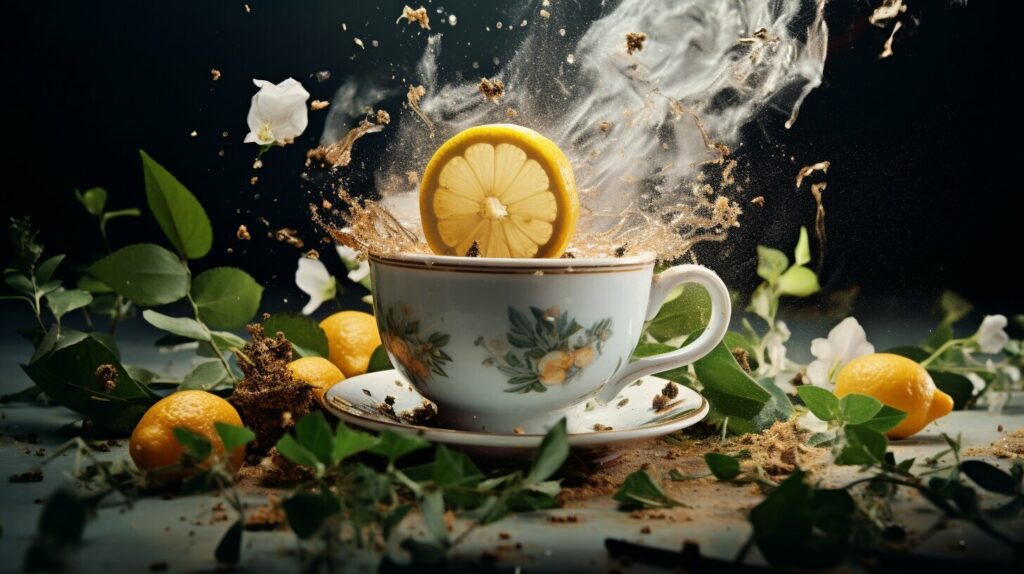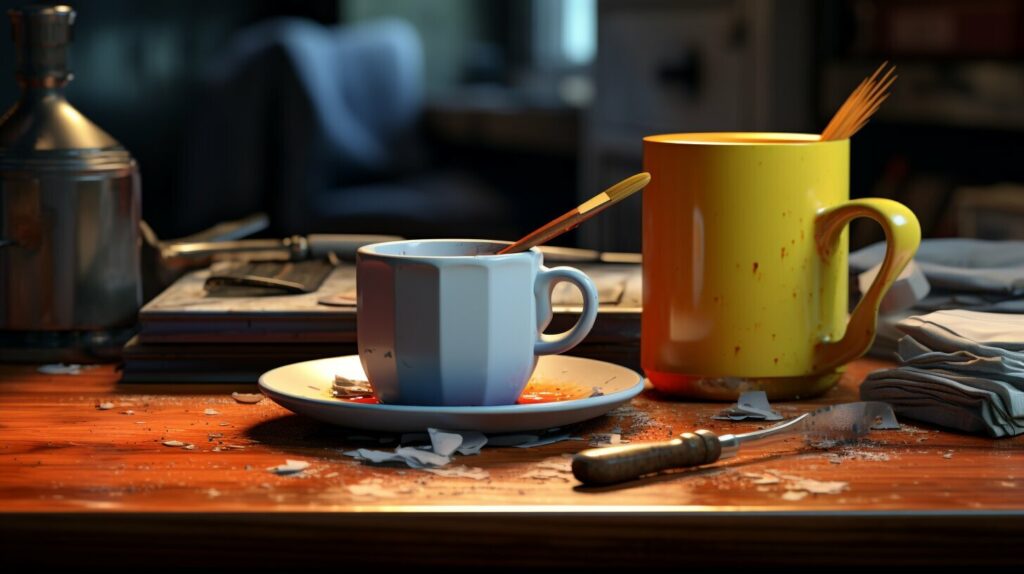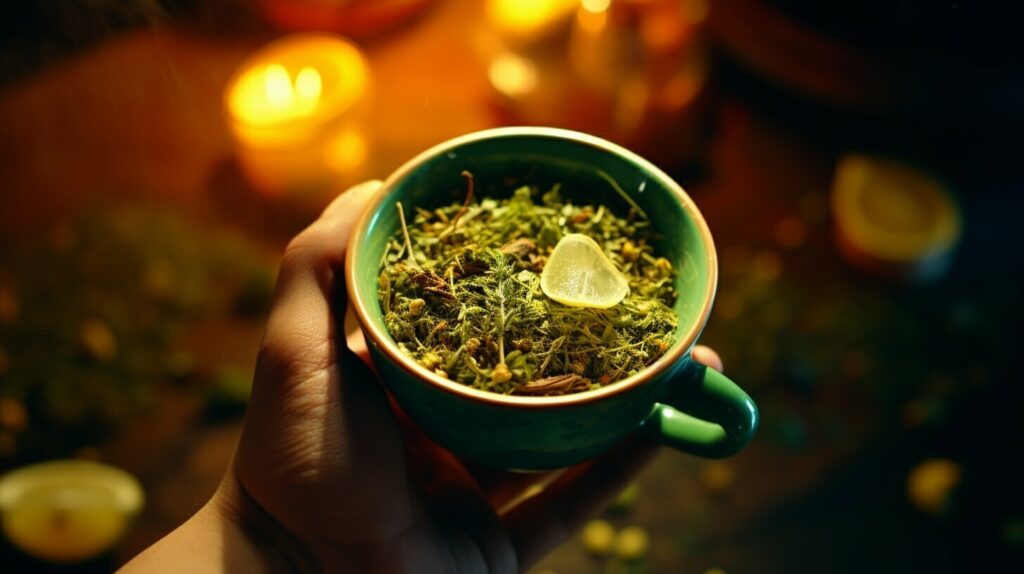
Are you tired of dealing with stubborn tea stains in your favorite cups? Discover effective methods and tips on how to prevent tea stains in cups, ensuring a clean and pristine teatime.
Key Takeaways:
- Use a lemon wedge and baking soda to rub the inside of the cup and then scrub with a damp sponge.
- Pour bleach into the mug, let it sit, and then rinse thoroughly to remove tea stains.
- Using filtered water for brewing tea can help prevent stains in cups.
- Immediately remove the tea bag from the cup and rinse it after finishing your drink.
- Regularly scrub the cup and use dish soap, baking soda, or vinegar to remove existing stains.
Easy and Natural Methods for Tea Stain Prevention
Say goodbye to tea stains with simple and natural methods that will keep your cups spotless. From using lemon and baking soda to opting for filtered water, these techniques will help prevent tea stains from forming in the first place.
One effective method is to use a lemon wedge and baking soda. Start by rubbing the lemon wedge on the inside of the cup, focusing on areas with visible stains. Then, pour a small amount of baking soda into the cup and let it sit for about 2 minutes. Afterward, use a damp sponge to scrub the cup gently. The natural acid in lemon and the abrasiveness of baking soda work together to remove tea stains.
Another great option is to use bleach. While this may not be suitable for all cup materials, it can be highly effective in removing tough tea stains. Simply pour a small amount of bleach into the cup and let it sit for 10-15 minutes. Then, rinse the cup thoroughly with water. Remember to follow safety precautions and ensure proper ventilation while using bleach.
Using filtered water for brewing your tea can also play a significant role in preventing stains. Tap water often contains minerals and impurities that can leave behind residue. By using filtered water, you can reduce the chances of tea stains forming in your cup. Additionally, remember to remove the tea bag promptly after steeping and rinse the cup immediately after finishing your drink. These immediate actions can prevent tea stains from setting in.
Tea Stain Prevention Techniques Summary:
- Use a lemon wedge and baking soda to remove stains naturally
- Consider using bleach for tougher stains (if suitable for cup material)
- Brew tea with filtered water to minimize impurities
- Remove tea bag promptly and rinse cup immediately after use
| Method | Effectiveness |
|---|---|
| Lemon and baking soda | Effective for mild stains |
| Bleach | Highly effective for tough stains (if suitable for cup material) |
| Filtered water | Prevents stains from forming |
| Immediate actions | Minimizes the chances of stains setting in |
The Power of Bleach for Tea Stain Removal
When it comes to tackling stubborn tea stains, bleach can be your ally. Learn how to harness the power of bleach to keep your cups free from any tea discoloration.
First, ensure that your cup is safe for bleach use. Check the bottom of the cup for any warnings or indications that it is not bleach-resistant. Once confirmed, proceed with caution.
To begin, dilute the bleach with water. Create a mixture of one part bleach to four parts water in a separate container. Avoid using undiluted bleach directly on the cup, as it can damage the material.
Next, gently pour the diluted bleach into the stained cup, ensuring that the entire interior is coated. Let the bleach sit for 10-15 minutes to allow it to penetrate and break down the tea stains.
| Benefits of Using Bleach for Tea Stain Removal | |
|---|---|
| Effective stain removal: | Bleach is a powerful agent that can effectively remove even the toughest tea stains, restoring the original color of your cup. |
| Kills bacteria: | Bleach has disinfecting properties that can help eliminate any bacterial buildup in your cups. |
| Easy to use: | The process of using bleach is simple and requires minimal effort. It is a convenient solution for removing tea stains. |
After the designated time, thoroughly rinse the cup with water to remove any remaining bleach. It is essential to ensure that no traces of bleach are left behind, as it can be harmful if ingested.
Remember, bleach should be used sparingly and with caution. It is always recommended to test a small, inconspicuous area of the cup first to check for any adverse reactions or damage.
By utilizing the power of bleach, you can bid farewell to tea stains in your cups and enjoy a clean and stain-free tea drinking experience.
Immediate Actions to Maintain Cup Cleanliness
Preventing tea stains starts with taking immediate actions. Learn essential tips and tricks to maintain cup cleanliness and avoid those pesky tea stains from setting in.
When you finish your cup of tea, don’t let it sit around for too long. Remove the tea bag promptly to prevent the tea from seeping into the cup and leaving stains. Rinse the cup with warm water immediately after use to remove any residue. This simple step can go a long way in keeping your cups stain-free.
To further ensure cup cleanliness, consider using dish soap. After rinsing with warm water, apply a small amount of dish soap to a sponge or cloth and gently scrub the inside of the cup. This will help remove any stubborn tea stains that may have already started to form.
“The quicker you take action and clean your cup, the better chance you have of preventing tea stains.”
If you’re dealing with particularly stubborn tea stains, you can also try using baking soda or vinegar. Create a paste with either of these ingredients, apply it to the stained areas, and let it sit for a few minutes. Then, scrub the cup with a sponge or brush to remove the stains. Rinse thoroughly afterward to ensure no residue remains.
Table 1: Recommended Actions for Maintaining Cup Cleanliness
| Action | Description |
|---|---|
| Remove tea bag promptly | Prevents tea from seeping into the cup and causing stains |
| Rinse with warm water | Removes any residue left by the tea and prevents staining |
| Use dish soap and scrub | Helps remove stubborn tea stains that may have formed |
| Try baking soda or vinegar | Creates a paste to remove stubborn stains, followed by thorough rinsing |
By following these immediate actions and incorporating them into your tea-drinking routine, you can keep your cups stain-free and enjoy a flawless teatime experience. Remember, the quicker you take action and clean your cup, the better chance you have of preventing tea stains. Cheers to a perfectly clean cup!
Effective Methods for Removing Existing Stains
If you’re dealing with stubborn tea stains that have already set in, don’t worry! Discover effective methods and techniques to remove cup discoloration caused by tea. One natural and easy method is to use a lemon wedge and baking soda. Simply rub the lemon wedge on the inside of the cup, then sprinkle in some baking soda. Let it sit for about 2 minutes, allowing the acidic properties of the lemon to break down the stains. Afterward, grab a damp sponge and gently scrub the cup, rinsing thoroughly. This method not only removes stains but also leaves your cup smelling fresh and clean.
Another powerful method for stain removal is using bleach. Pour a small amount of bleach into the stained mug, enough to cover the affected area. Let it sit for 10-15 minutes, allowing the bleach to work its magic. Remember to wear gloves and work in a well-ventilated area when handling bleach. After the designated time, thoroughly rinse the cup with water until the bleach smell dissipates. This method is particularly useful for stubborn tea stains that seem impossible to remove.
Prevention is always better than cure, so using filtered water to brew your tea can help prevent cup discoloration in the first place. Filtering your water removes impurities and minerals that can contribute to stains. Additionally, it’s vital to take immediate action after finishing your tea. Remove the tea bag promptly and rinse the cup with water to remove any remaining residue. By being proactive, you can minimize the chances of tea stains setting in.
| Method | Ingredients/Steps |
|---|---|
| Lemon and Baking Soda | – Rub a lemon wedge on the inside of the cup – Sprinkle baking soda and let it sit for 2 minutes – Scrub with a damp sponge and rinse |
| Bleach | – Pour bleach into the stained mug and let it sit for 10-15 minutes – Rinse thoroughly |
| Filtered Water | – Use filtered water to brew your tea |
| Immediate Action | – Remove the tea bag promptly – Rinse the cup after finishing |
For existing stains that are proving to be stubborn, regular maintenance is key. Scrubbing the cup with dish soap, baking soda, or vinegar helps to break down the stains over time. Create a paste using any of these ingredients, apply it to the stains, and scrub gently with a sponge or brush. Repeat the process until the stains fade away. Remember to rinse the cup thoroughly after cleaning to remove any residue. With consistent effort, you can restore your cup to its pristine condition.
Remember, prevention and immediate action are crucial in keeping your cups stain-free. But if tea stains do appear, don’t panic. With these effective methods and techniques for removing existing stains, your cups will be spotless and ready for your next delightful tea time!
Conclusion
Bid farewell to tea stains in cups by implementing these practical tips and methods, ensuring a spotless and enjoyable teatime experience. To prevent stains, you can try using a lemon wedge and baking soda. Simply rub the lemon wedge on the inside of the cup, pour in some baking soda, let it sit for a couple of minutes, and then scrub with a damp sponge. This natural method helps remove any stubborn stains and leaves your cups looking clean and fresh.
Another effective method is to use bleach. Pour a small amount of bleach into the mug, let it sit for 10-15 minutes, and then rinse thoroughly. Bleach is a powerful tool for removing tea stains and can help keep your cups stain-free. However, be sure to handle bleach with care and follow all safety precautions.
Using filtered water for your tea can also play a significant role in stain prevention. Filtered water helps eliminate impurities that can contribute to tea stains. Additionally, make it a habit to remove the tea bag promptly after brewing and rinse the cup immediately after finishing your drink. These simple actions can make a big difference in maintaining cup cleanliness.
In case you already have existing stains, there are solutions to remove them as well. Regular scrubbing with dish soap, baking soda, or vinegar can be effective in getting rid of tea stains. These household ingredients work wonders in breaking down the stains and restoring the shine to your cups. Remember to scrub gently to avoid damaging the cup’s surface.
By following these tips and methods, you can enjoy a stain-free teatime and savor every sip without worrying about unsightly marks in your cups. So go ahead, implement these techniques, and elevate your tea-drinking experience to a whole new level of cleanliness and enjoyment.
FAQ
Q: How can I prevent tea stains in cups?
A: There are several methods you can use to prevent tea stains in cups. Some options include using a lemon wedge and baking soda, using bleach, using filtered water, and removing the tea bag promptly after use.
Q: How do I use a lemon wedge and baking soda to prevent tea stains?
A: Simply rub a lemon wedge on the inside of the cup and then pour in baking soda. Let it sit for 2 minutes and then scrub with a damp sponge.
Q: Can I use bleach to prevent tea stains?
A: Yes, you can. Pour bleach into the mug, let it sit for 10-15 minutes, and then rinse thoroughly. Be sure to handle bleach with caution and follow safety instructions.
Q: Does using filtered water help prevent tea stains?
A: Yes, using filtered water can help prevent tea stains. Impurities present in tap water can contribute to staining, so using filtered water for brewing your tea can reduce the likelihood of stains.
Q: Why is it important to remove the tea bag promptly and rinse the cup after use?
A: Removing the tea bag promptly and rinsing the cup immediately after use helps prevent tea stains from setting in. The remnants of the tea bag and the tea itself can cause discoloration if left for too long.
Q: How can I remove existing tea stains from cups?
A: To remove existing tea stains, you can try using dish soap, baking soda, or vinegar while scrubbing the cup. Regular scrubbing and using these cleaning agents can help remove stubborn stains.









